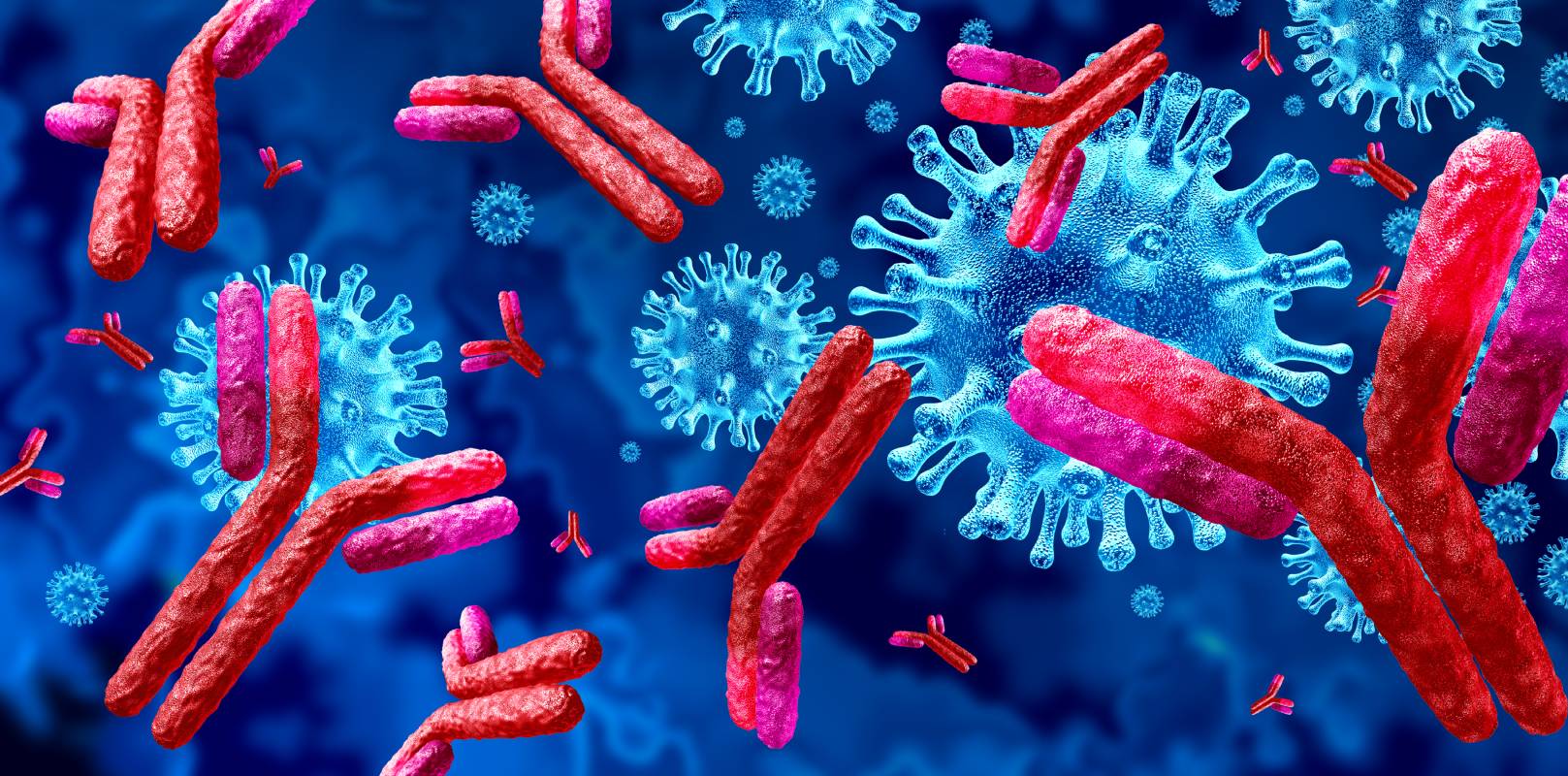The COVID-19 pandemic, caused by the virus SARS-CoV-2, is still a global problem. Research on protection due to antibodies after COVID-19 infection (and vaccination) can contribute to clinical knowledge and more informed public health strategies.
Antibodies, also called immunoglobulins (Ig), are created by the plasma cells (mature B cells) of the immune system. The antibodies recognize and bind to a specific pattern or structure, called the antigen. Antibodies prevent harm by neutralizing a pathogen’s ability to enter cells or by marking the pathogen for attack by specialized immune cells (Durani, 2014). After a first infection, the body will keep some of the plasma cells as memory B cells, so that if the pathogen is encountered again, the antibody response will be quicker and more powerful (Cagiga et al, 2021).
The body makes five different types of antibodies: IgG, IgM, IgA, IgE and IgD. IgG is the most common antibody type and is a smaller protein that is found throughout the body. IgM is the first antibody type made upon infection and is found primarily in blood and lymph fluid. IgA is found mostly in mucous membranes, including in the respiratory tracts. IgE is mostly seen in allergic reactions, and IgD exists in only small amounts and its purpose is not understood (Durani, 2014). IgG, IgM and IgA are the types of antibodies that are relevant to SARS-CoV-2 infection.
For SARS-CoV-2, the antibody can attach to an antigen from either the virus’s spike glycoprotein (S antibodies) or nucleocapsid protein (N antibodies). The virus’s spike protein contains the receptor binding domain (RBD) that the virus uses to enter host cells; S antibodies against the RBD are more likely to be neutralizing (Cagiga et al, 2021). A neutralizing antibody prevents the virus from entering the host cell and reproducing. In comparison to S antibodies, N antibodies have not been found to provide protection against infection (Cagiga et al, 2021).
In response to COVID-19 infection, IgM antibodies are produced first throughout the body; it reacts strongly to antigens (high avidity) and ultimately represents 10% of the serum antibodies. IgG appears later and has high capacity for neutralization (Zhu et al, 2021). IgG and IgA are also produced locally from cells in the airway. IgA from the airway has been seen to peak at high levels early in infection and then begin to decline. Airway IgG and IgA levels waned significantly by 3 months post-infection in a study of 147 patients (Cagiga et al, 2021). Systemic IgM levels also declined significantly by the third month, and systemic IgG levels were observed to slightly decline (Zhu et al, 2021).
Despite declining levels, a high percentage of patients were still seropositive for IgG seven months after infection; in other words, they still had significant IgG reaction against a SARS-CoV-2 challenge. IgG antibodies after COVID-19 infection may stay in the body for up to two years (Zhu et al, 2021). It was also found that around 25% of patients still were seropositive for IgM after 6 to 9 months. However, all antibodies were found to decrease in neutralizing ability over time (Zhu et al, 2021).
In addition to antibody type, levels, and neutralizing ability, antibody avidity also plays a role in effectiveness. Avidity is how strongly the antibody binds to its antigen. With SARS-CoV-2, antibody avidity increased three months after infection when antibody levels started to decline, in a process called avidity maturation. High avidity antibodies may be associated with a lower risk of reinfection (Löfström et al, 2021).
Antibodies after recovery from COVID-19 were seen to vary based on disease severity. Patients recovering from a severe or critical disease were seropositive for IgG and IgM after approximately 7 months at a significantly higher rate than patients with asymptomatic infection (Zhu et al, 2021). Patients with low viral loads in the respiratory tract also may not develop antibodies at all (non-seroconversion) (Liu et al, 2021).
Age also impacted antibodies after recovery. Kids and adolescents were found to have the lowest rates of seropositivity for IgG and IgM, with adults under 60 having the highest rates and adults older than 60 falling in between. Luckily, children were more likely to have a less violent immune response and only mild symptoms, if any at all (Liu et al, 2021).
References
Cagigi A, Yu M, Österberg B, et al. Airway antibodies emerge according to COVID-19 severity and wane rapidly but reappear after SARS-CoV-2 vaccination. JCI Insight. 2021;6(22):e151463. Published 2021 Nov 22. doi:10.1172/jci.insight.151463
Löfström E, Eringfält A, Kötz A, et al. Dynamics of IgG-avidity and antibody levels after Covid-19. J Clin Virol. 2021;144:104986. doi:10.1016/j.jcv.2021.104986
Liu W, Russell RM, Bibollet-Ruche F, et al. Predictors of Nonseroconversion after SARS-CoV-2 Infection. Emerg Infect Dis. 2021;27(9):2454-2458. doi:10.3201/eid2709.211042.
Durani Y. Blood Test: Immunoglobulins (IgA, IgG, IgM). Rady Children’s Hospital San Diego- rchsd.org. 2014. https://www.rchsd.org/health-articles/blood-test-immunoglobulins-iga-igg-igm/
Zhu L, Xu X, Zhu B, et al. Kinetics of SARS-CoV-2 Specific and Neutralizing Antibodies over Seven Months after Symptom Onset in COVID-19 Patients. Microbiol Spectr. 2021;9(2):e0059021. doi:10.1128/Spectrum.00590-21

